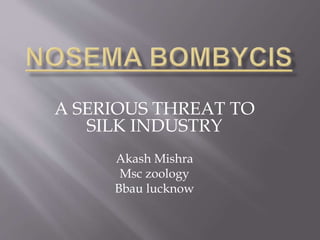
Nossima: a serious threat to silkworm
- 1. A SERIOUS THREAT TO SILK INDUSTRY Akash Mishra Msc zoology Bbau lucknow
- 2. Nosema bombycis is a microsporidian protozoa causes PEBRINE disease of silkworm. It was first recorded in France in 1845 and later spread to Italy, Spain, Syria and Romania. ' It was responsible for the collapse of the French and Italian silkworm industry in 1865. The name pebrine was coined by De Quadrefagues (1860) because of pepper-like spots seen on the diseased larvae in advanced stage of infection. The disease is known as KATA or MATHA KATA in Bengali and as GANTU or GANTU ROGA iii Kannaaad.
- 3. The life cycle of N.bombycis includes three stages namely SPORE, PLANONT and MERONT.Mature spore is oval or ovocylindrical and measures 3-4 microns by 1.5-2.0 microns with 3 layered membrane,the inner,middle and outer.they can be observed at 600 magnification under a microscope.the spore consists of; Spore membrane,which enclose the sporoplasm. Sporoplasmin the form of a girdle across the width of the spore
- 4. Anterior and posterior vacuoles. Two nuclei in the sporoplasm. Posterior capsule.
- 6. The spores are highly refrecting appearing light green under microscope.the spore belongs to the dormant stage of pathogen and posses great resistance . The spores germinates in digestive juice of silkworm larva and produces a long polar fillament having a length of more than 30 times that of the lengthwise dimension of the spore,on the end of which grows a sporoplasm. The sporoplasm is having two nuclei and other cell organ and posses the limiting membrane. The sporoplasm multiplies through fisssion, comes out of heamolymph intracelluar space spreading to every part of body,and lives in various system particularly in the fat body and muscular tissue,becomes a nucleus and form spore after multiplication through fission.
- 7. The pathogen of pebrine diseases is capable to complete its life cycle within four days. The pathogen parasitizes the ovary first and when 4 and 5 instar larvae after pupation and emergence becomes moth they move into egg and after deposition of eggs undergo multiplication and develops into the disease in the embryo or in the body of silkworm in next generation. After the deposition of eggs the pathogen grows and multiplies within the egg. The mature spore is unicellular, endomembranous differentiation of its sporoblast.
- 8. Phylum -Protozoa Order -Microsporidia Balbiani ( 1882) Family -Nosematidae Labbe (1899) Genus -Nosema Naegeli (1857) Species -Nosema bombycis Naegeli (1857)
- 9. Transovarial transmission and per os infection are the two routes of pebrine infection in silkworm. A-Transovarial/Embryonic/Vertical Transmission: Embryonic infection occurs when the pathogen infects the fourth or fifth instar larvae in which it invades the epithelial cells of the ovaries and then the parasites are transferred to the oogonia, oocytes and nutritive cells.
- 11. i) Egg stage: The eggs laid by moth are fewer and do not firmly attach to the egg sheet. ” The number of dead and unfertilized eggs is higher. ” The hatching is irregular and number of hatched eggs is fewer. s to moult. ” The silk gland will have white pustules on its surface. ” The dead larvae remain rubbery for sometimes and then turn black. ii) Larval stage: ” The diseased larvae will have poor appetite, retarded growth, undersized and flaccid. ” The larvae are comparatively paler, translucent and delays to moult. ” The silk gland will have white pustules on its surface. ” The dead larvae remain rubbery for sometimes and then turn black
- 14. When spores of N. bombycis were ingested by silkworm larvae, the inner part of the spore lost its affinity and small sporoplasm discharged from the spores developed into large ovoid cells with two nuclei and a vacole. The sporoplasms were observed in the peri trophic membrane and microvilli of the midgut (Abe, 1978a). Histological observations on silkworm larvae orally infected in the 2nd instar with N. bombycis spores revealed that after 24 hour Nosema cells occurred only in the granulocytes (Abe, I 978a)
- 15. Detection and elimination of pebrine disease is essential for sustenance of cocoon crop from industrial point of view. The age old detection procedure, the only reliable and widely accepted technique for preparation of pebrine free eggs, is the one which involves examination of mother moth tissue smears under light microscope. The technique was developed by Louis Pasteur in 1870 and is still followed to detect the pebrine spore in the field of commercial seed production in all silk producing countries including India. Thereafter, though many novel techniques were developed to detect pebrine spore, the popularity of the mother moth examination has not been dwindled. Due to many practical reasons, the other detection procedures remained only as of theoretical interest for the researchers.
- 16. The fundmental measure in the control of this disease is production of innocus eggs,which which would preclude embryonic infection.inspection of the mother of silkworm moths,corrective inspection for pebrine ,and disease prevention and mangement in the egg producing farms should be carefully undertaken.strict implementation of the supervising regulstions should be carried out
- 17. Crop loss is a regular feature associated with Indian sericulture scenario for various reasons. It may be accounted for different sorts of disease, parasites, weather conditions or even for cultural reasons. But none of them is as severe as the larval mortality owing to pebrine disease where the entire crop is lost. The causative agent for the disease is Nosema bombycis Nageli, a spore forming eukaryotic, obligatory and intracellular protozoan. Detection and elimination of pebrine disease is essential for sustenance of cocoon crop from industrial point of view
